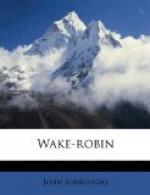Approaching this region from the Hudson River side, you cross a rough, rolling stretch of country, skirting the base of the Catskills, which from a point near Saugerties sweep inland; after a drive of a few hours you are within the shadow of a high, bold mountain, which forms a sort of butt-end to this part of the range, and which is simple called High Point. To the east and southeast it slopes down rapidly to the plain, and looks defiance toward the Hudson, twenty miles distant; in the rear of it, and radiating from it west and northwest, are numerous smaller ranges, backing up, as it were, this haughty chief.
From this point through to Pennsylvania, a distance of nearly one hundred miles, stretches the tract of which I speak. It is a belt of country from twenty to thirty miles wide, bleak and wild, and but sparsely settled. The traveler on the New York and Erie Railroad gets a glimpse of it.
Many cold, rapid trout streams, which flow to all points of the compass, have their source in the small lakes and copious mountain springs of this region. The names of some of them are Mill Brook, Dry Brook, Willewemack, Beaver Kill, Elk Bush Kill, Panther Kill, Neversink, Big Ingin, and Callikoon. Beaver Kill is the main outlet on the west. It joins the Deleware in the wilds of Hancock. The Neversink lays open the region to the south, and also joins the Delaware. To the east, various Kills unite with the Big Ingin to form the Esopus, which flows into the Hudson. Dry Brook and Mill Brook, both famous trout streams, from twelve to fifteen miles long, find their way into the Delaware.
The east or Pepacton branch of the Delaware itself takes its rise near here in a deep pass between the mountains. I have many times drunk at a copious spring by the roadside, where the infant river first sees the light. A few yards beyond, the water flows the other way, directing its course through the Bear Kill and Schoharie Kill into the Mohawk.
Such game and wild animals as still linger in the State are found in this region. Bears occasionally make havoc among the sheep. The clearings at the head of a valley are oftenest the scene of their depredations.
Wild pigeons, in immense numbers used to breed regularly in the valley of the Big Ingin and about the head of the Neversink. The treetops for miles were full of their nests, while the going and coming of the old birds kept up a constant din. But the gunners soon got wind of it, and from far and near were wont to pour in during the spring, and to slaughter both old and young. This practice soon had the effect of driving the pigeons all away, and now only a few pairs breed in these woods.
Deer are still met with, though they are becoming scarcer every year. Last winter near seventy head were killed on the Beaver Kill alone. I heard of one wretch, who, finding the deer snowbound, walked up to them on his snowshoes, and one morning before breakfast slaughtered six, leaving their carcasses where they fell. There are traditions of persons having been smitten blind or senseless when about to commit some heinous offense, but the fact that this villain escaped without some such visitation throws discredit on all such stories.




